Innovative Feasibility Study for the Reclamation of the Cascajo Wetlands in Peru Utilizing Sustainable Technologies
Abstract
1. Introduction
2. Materials and Methods
2.1. Study Site
2.2. Removal of Invasive Species from Wetlands
2.3. Micro-Nano Bubbles (MNBs)
2.4. Ceramic-Based Bio-Filters (CBBFs)
2.5. Bio-Fence Preparation
2.6. Sampling
2.7. Remote Sensing
2.8. Statistical Analysis
3. Results and Discussion
3.1. The Effect of MNBs
3.2. The Effect of CBBFs
3.3. The Effect of Bio-fence
3.4. Remote Sensing and Correlation Analysis
4. Conclusions
Supplementary Materials
Author Contributions
Funding
Acknowledgments
Conflicts of Interest
References
- Cohen-Shacham, E.; Andrade, A.; Dalton, J.; Dudley, N.; Jones, M.; Kumar, C.; Maginnis, S.; Maynard, S.; Nelson, C.R.; Renaud, F.G.; et al. Core Principles for Successfully Implementing and Upscaling Nature-Based Solutions. Environ. Sci. Policy 2019, 98, 20–29. [Google Scholar] [CrossRef]
- Dushkova, D.; Haase, D. Not Simply Green: Nature-Based Solutions as a Concept and Practical Approach for Sustainability Studies and Planning Agendas in Cities. Land 2020, 9, 19. [Google Scholar] [CrossRef]
- Kabisch, N.; Bosch, M.V.D.; Lafortezza, R. The Health Benefits of Nature-Based Solutions to Urbanization Challenges for Children and the Elderly—A Systematic Review. Environ. Res. 2017, 159, 362–373. [Google Scholar] [CrossRef] [PubMed]
- Nesshöver, C.; Assmuth, T.; Irvine, K.; Rusch, G.; Waylen, K.; Delbaere, B.; Haase, D.; Jones-Walters, L.; Keune, H.; Kovács, E.; et al. The Science, Policy and Practice of Nature-Based Solutions: An Interdisciplinary Perspective. Sci. Total. Environ. 2017, 579, 1215–1227. [Google Scholar] [CrossRef] [PubMed]
- Albert, C.; Schröter, B.; Haase, D.; Brillinger, M.; Henze, J.; Herrmann, S.; Gottwald, S.; Guerrero, P.; Nicolas, C.; Matzdorf, B. Addressing Societal Challenges through Nature-Based Solutions: How Can Landscape Planning and Governance Research Contribute? Landsc. Urban Plan. 2019, 182, 12–21. [Google Scholar] [CrossRef]
- Sang, N. (Ed.) Modelling Nature-Based Solutions: Integrating Computational and Participatory Scenario Modelling for Environmental Management and Planning; Cambridge University Press: Cambridge, UK, 2020. [Google Scholar]
- Hanson, H.I.; Wickenberg, B.; Olsson, J.A. Working on the Boundaries—How Do Science Use and Interpret the Nature-Based Solution Concept? Land Use Policy 2020, 90, 104302. [Google Scholar] [CrossRef]
- Thorslund, J.; Destouni, G.; Jaramillo, F.; Jawitz, J.; Manzoni, S.; Basu, N.B.; Chalov, S.R.; Cohen, M.J.; Creed, I.F.; Goldenberg, R.; et al. Wetlands as Large-Scale Nature-Based Solutions: Status and Challenges for Research, Engineering and Management. Ecol. Eng. 2017, 108, 489–497. [Google Scholar] [CrossRef]
- Pauleit, S.; Zölch, T.; Hansen, R.; Randrup, T.B.; Konijnendijk van den Bosch, C. Nature-Based Solutions and Climate Change—Four Shades of Green. In Nature-Based Solutions to Climate Change Adaptation in Urban Areas. Theory and Practice of Urban Sustainability Transitions; Kabisch, N., Korn, H., Stadler, J., Bonn, A., Eds.; Springer: Cham, Switzerland, 2017. [Google Scholar]
- Hu, T.; Liu, J.; Zheng, G.; Li, Y.; Xie, B. Quantitative Assessment of Urban Wetland Dynamics Using High Spatial Resolution Satellite Imagery between 2000 and 2013. Sci. Rep. 2018, 8, 7409. [Google Scholar] [CrossRef]
- Hook, D.D. Wetlands: History, Current Status, and Future. Environ. Environ. Toxicol. Chem. 1993, 12, 2157–2166. [Google Scholar] [CrossRef]
- Bai, J.; Huang, L.; Gao, H.; Zhang, G. Wetland Biogeochemistry and Ecological Risk Assessment. Phys. Chem. Earth 2017, 97, 1–2. [Google Scholar] [CrossRef]
- Guzy, J.C.; Mccoy, E.D.; Deyle, A.C.; Gonzalez, S.M.; Halstead, N.; Mushinsky, H.R. Urbanization Interferes with the Use of Amphibians as Indicators of Ecological Integrity of Wetlands. J. Appl. Ecol. 2012, 49, 941–952. [Google Scholar] [CrossRef]
- Mutiti, S.; Sadowski, H.; Melvin, C.; Mutiti, C. Effectiveness of Man-Made Wetland Systems in Filtering Contaminants from Urban Runoff in Milledgeville, Georgia. Water Environ. Res. 2015, 87, 358–368. [Google Scholar] [CrossRef] [PubMed]
- Phillips, R.L.; Ficken, C.; Eken, M.; Hendrickson, J.; Beeri, O. Wetland Soil Carbon in a Watershed Context for the Prairie Pothole Region. J. Environ. Qual. 2016, 45, 368–375. [Google Scholar] [CrossRef] [PubMed]
- Withey, P.; van Kooten, G.C. The Effect of Climate Change on Optimal Wetlands and Waterfowl Management in Western Canada. Ecol. Econ. 2011, 70, 798–805. [Google Scholar] [CrossRef]
- Guttery, R.S.; Poe, S.L.; Sirmans, C.F. Federal Wetlands Regulation: Restrictions on the Nationwide Permit Program and the Implications for Residential Property Owners. Am. Bus. Law J. 2000, 37, 299–342. [Google Scholar] [CrossRef]
- Chen, H.; Zou, J.; Cui, J.; Nie, M.; Fang, C. Wetland Drying Increases the Temperature Sensitivity of Soil Respiration. Soil Biol. Biochem. 2018, 120, 24–27. [Google Scholar] [CrossRef]
- Guo, M.; Li, J.; Sheng, C.; Xu, J.; Wu, L. A Review of Wetland Remote Sensing. Sensors (Switzerland) 2017, 17, 777. [Google Scholar] [CrossRef]
- Vos, J.; Vincent, L. Volumetric Water Control in a Large-Scale Open Canal Irrigation System with Many Smallholders: The Case of Chancay-Lambayeque in Peru. Agric. Water Manag. 2011, 98, 705–714. [Google Scholar] [CrossRef]
- Boelens, R.; Vos, J. The Danger of Naturalizing Water Policy Concepts: Water Productivity and Efficiency Discourses from Field Irrigation to Virtual Water Trade. Agric. Water Manag. 2012, 108, 16–26. [Google Scholar] [CrossRef]
- Vera Delgado, J. The Socio-Cultural, Institutional and Gender Aspects of the Water Transfer-Agribusiness Model for Food and Water Security. Lessons Learned from Peru. Food Secur. 2015, 7, 1187–1197. [Google Scholar] [CrossRef]
- The World Bank—WB. Peru: Hydro-Economic Analysis and Prioritization of Water Resource Initiatives; The World Bank: Washington, DC, USA, 2015; Available online: https://www.2030wrg.org/wp-content/uploads/2015/05/2030-WRG_Peru-Final-Report_English.pdf (accessed on 1 December 2019).
- Aponte, H.; Jiménez, R.; Alcántara, B. Challenges for Management and Conservation of Santa Rosa Wetland Peru. Científica 2012, 9, 1–9. [Google Scholar]
- Cano, A. «Top-Down» or «Bottom-Up»? Social Participation, Agriculture and Mining in the Integrated Management of the Chancay-Lambayeque Watershed. Apuntes 2013, 73, 43–76. [Google Scholar] [CrossRef]
- ECLAC/OECD. Environmental Performance Reviews: Peru, 2016, Highlights and recommendations. Available online: https://repositorio.cepal.org/bitstream/handle/11362/40172/1/S1600312_en.pdf (accessed on 11 April 2020).
- Aponte, H.; Ramírez, D. Humedales De La Costa Central Del Perú: Estructura Y Amenazas De Sus Comunidades Vegetales. Ecol. Apl. 2011, 10, 2011. [Google Scholar]
- Ramirez, D.W.; Aponte, H.; Cano, A. Flora Vascular y Vegetación Del Humedal de Santa Rosa (Chancay, Lima). Rev. Peru. Biol. 2011, 17, 105–110. [Google Scholar] [CrossRef]
- Burkett, V.; Kusler, J. Climate Change: Potential Impacts and Interactions in Wetlands of the United States. J. Am. Water Resour. Assoc. 2000, 36, 313–320. [Google Scholar] [CrossRef]
- Park, J.B.K.; Rupert, J.; Craggs, J.; Tanner, C.T. Eco-Friendly and Low-Cost Enhanced Pond and Wetland (EPW) System for the Treatment of Secondary Wastewater Effluent. Ecol. Eng. 2018, 120, 170–179. [Google Scholar] [CrossRef]
- Osland, M.J.; Enwright, N.M.; Day, R.H.; Gabler, C.A.; Camille, L.; Stagg, C.L.; Grace, J.B. Beyond Just Sea-Level Rise: Considering Macroclimatic Drivers within Coastal Wetland Vulnerability Assessments to Climate Change. Glob. Chang. Biol. 2015, 22, 1–11. [Google Scholar] [CrossRef]
- Lavado-Casimiro, W.; Espinoza, J.C. Impactos de El Niño y La Niña En Las Lluvias Del Perú (1965–2007). Rev. Bras. Meteorol. 2014, 29, 171–182. [Google Scholar] [CrossRef]
- Rau, P.; Bourrel, L.; Labat, D.; Frappart, F.; Ruelland, D.; Lavado, W.; Dewitte, B.; Felipe, O. Hydroclimatic Change Disparity of Peruvian Pacific Drainage Catchments. Theor. Appl. Clim. 2017, 134, 139–153. [Google Scholar] [CrossRef]
- Day, J.W.; Alejandro Yañéz, A.; Mitsch William, J.; Ana Laura, L.-D.; Day, J.N.; Jae, Y.K.; Robert, L.; Joel, L.; David, Z.L. Using Ecotechnology to Address Water Quality and Wetland Habitat Loss Problems in the Mississippi Basin: A Hierarchical Approach. Biotechnol. Adv. 2003, 22, 135–159. [Google Scholar] [CrossRef]
- Zhang, C.; Zhu, M.-Y.; Zeng, G.-M.; Yu, Z.; Cui, F.; Yang, Z.-Z.; Shen, L.-Q. Active Capping Technology: A New Environmental Remediation of Contaminated Sediment. Environ. Sci. Pollut. Res. 2016, 23, 4370–4386. [Google Scholar] [CrossRef] [PubMed]
- Eckley, C.S.; Gilmour, C.C.; Janssen, S.; Luxton, T.P.; Randall, P.M.; Whalin, L.; Austin, C. The Assessment and Remediation of Mercury Contaminated Sites: A Review of Current Approaches. Sci. Total. Environ. 2020, 707, 136031. [Google Scholar] [CrossRef] [PubMed]
- Gensemer, R.W.; Playle. R.C. Critical Reviews in Environmental Science and Technology: The Bioavailability and Toxicity of Aluminum in Aquatic Environments The Bioavailability and Toxicity of Aluminum in Aquatic Environments. Crit. Rev. Environ. Sci. Technol. 1999, 294, 37–41. [Google Scholar] [CrossRef]
- Ayeni, O.; Kambizi, L.; Laubscher, C.; Fatoki, O.S.; Olatunji, O. Risk Assessment of Wetland under Aluminium and Iron Toxicities: A Review. Aquat. Ecosyst. Heal. Manag. 2014, 17, 122–128. [Google Scholar] [CrossRef]
- Da Silva, M.B.; Abrantes, N.; Nogueira, V.; Gonçalves, F.J.M.; Pereira, R. TiO2 Nanoparticles for the Remediation of Eutrophic Shallow Freshwater Systems: Efficiency and Impacts on Aquatic Biota under a Microcosm Experiment. Aquat. Toxicol. 2016, 178, 58–71. [Google Scholar] [CrossRef]
- Pester, M.; Knorr, K.-H.; Friedrich, M.W.; Wagner, M.; Loy, A. Sulfate-Reducing Microorganisms in Wetlands—Fameless Actors in Carbon Cycling and Climate Change. Front. Microbiol. 2012, 3, 1–19. [Google Scholar] [CrossRef]
- Lamia, A.; Hamdi, M. Fermentative Decolorization of Olive Mill Wastewater by Lactobacillus Plantarum. Process. Biochem. 2003, 39, 59–65. [Google Scholar] [CrossRef]
- Golalikhani, M.; Razavi, S.H. An Efficient Biological Treatment on Dairy Wastewater by Lactobacillus Plantarum: Mathematical Modeling and Process Parameters Optimization. Int. J. Food Eng. 2016, 12, 63–73. [Google Scholar] [CrossRef]
- Guerra, F.D.; Attia, M.F.; Whitehead, D.C.; Alexis, F. Nanotechnology for Environmental Remediation: Materials and Applications. Molecules (Basel Switzerland) 2018, 23, 1760. [Google Scholar] [CrossRef]
- Dewidar, K.; Khedr, A. Water Quality Assessment with Simultaneous Landsat-5 TM at Manzala Lagoon, Egypt. Hydrobiologia 2001, 457, 49–58. [Google Scholar] [CrossRef]
- Xu, P.; Niu, Z.; Tang, P. Comparison and Assessment of NDVI Time Series for Seasonal Wetland Classification. Int. J. Digit. Earth 2017, 11, 1103–1131. [Google Scholar] [CrossRef]
- Arana, C. Relaciones Fitogeograficas de La Flora Vascular de Los Pantanos de Villa. In Los Pantanos de Villa: Biología y Conservación; Cano, A., Young, K.R., Eds.; Museo de Historia Natural-UNMSM: Lima, Peru, 2016; Volume 11, pp. 163–179. (In Spanish) [Google Scholar]
- Sridhar, M.K.C. Trace Elements. Acts Hydrochim. Hydrobiol. 1998, 16, 293–297. [Google Scholar] [CrossRef]
- Chan, K.S.; Page, R.A. Creep Damage Development in Structural Ceramics. J. Am. Ceram. Soc. 1993, 76, 803–826. [Google Scholar] [CrossRef]
- Bovea, M.D.; Saura, Ú.; Ferrero, J.L.; Giner, J. Cradle-to-Gate Study of Red Clay for Use in the Ceramic Industry. Int. J. Life Cycle Assess. 2006, 12, 439–447. [Google Scholar] [CrossRef]
- Raj, R. Fundamental Research in Structural Ceramics for Service Near 2000 °C. J. Am. Ceram. Soc. 1993, 76, 2147–2174. [Google Scholar] [CrossRef]
- Fadda, S.; Sanz, Y.; Vignolo, G.; Aristoy, M.C.; Oliver, G.; Toldrá, F. Hydrolysis of Pork Muscle Sarcoplasmic Proteins by Lactobacillus Curvatus and Lactobacillus Sake. Appl. Environ. Microbiol. 1999, 65, 578–584. [Google Scholar] [CrossRef]
- Li, Y.L.; Deletic, A.; Alcazar, L.; Bratieres, K.; Fletcher, T.D.; McCarthy, D.T. Removal of Clostridium Perfringens, Escherichia Coli and F-RNA Coliphages by Stormwater Biofilters. Ecol. Eng. 2012, 49, 137–145. [Google Scholar] [CrossRef]
- Briggiler, M.M.; Reinheimer, J.; Quiberoni, A. Phage Adsorption and Lytic Propagation in Lactobacillus Plantarum: Could Host Cell Starvation Affect Them? BMC Microbiol. 2015, 15, 1–7. [Google Scholar] [CrossRef][Green Version]
- Carranzo, I.V.; APHA; AWWA; WEF. Standard Methods for Examination of Water and Wastewater. An. Hidrol. Médica 2012, 5, 185–186. [Google Scholar] [CrossRef]
- Landsat Algorithms. Available online: https://developers.google.com/earth-engine/landsat (accessed on 1 December 2019).
- Chander, G.; Markham, B.L.; Helder, D.L. Summary of Current Radiometric Calibration Coefficients for Landsat MSS, TM, ETM+, and EO-1 ALI Sensors. Remote. Sens. Environ. 2009, 113, 893–903. [Google Scholar] [CrossRef]
- Huete, A.R.; Didan, K.; Miura, T.; Rodriguez, E.; Gao, X.; Ferreira, L. Overview of the Radiometric and Biophysical Performance of the MODIS Vegetation Indices. Remote. Sens. Environ. 2002, 83, 195–213. [Google Scholar] [CrossRef]
- Landsat 7 Collection 1 Tier 1 8-Day EVI Composite. Available online: https://developers.google.com/earth-engine/datasets/catalog/LANDSAT_LE07_C01_T1_8DAY_EVI (accessed on 1 December 2019).
- Wang, X.; Ma, T. Application of Remote Sensing Techniques in Monitoring and Assessing the Water Quality of Taihu Lake. Bull. Environ. Contam. Toxicol. 2001, 67, 863–870. [Google Scholar] [CrossRef]
- El-Zeiny, A.; El-Kafrawy, S. Assessment of water pollution induced by human activities in Burullus Lake using Landsat 8 operational land imager and GIS. Egypt. J. Remote Sens. Space Sci. 2017, 20, S49–S56. [Google Scholar] [CrossRef]
- World Bank. Peru—Integrated Water Resources Management in Ten Basins Project; World Bank: Washington, DC, USA, 2014. [Google Scholar]
- Verones, F.; Bartl, K.; Pfister, S.; Jiménez Vílchez, R.; Hellweg, S. Modeling the local biodiversity impacts of agricultural water use: case study of a wetland in the coastal arid area of Peru. Environ. Sci. Technol. 2012, 1, 4966–4974. [Google Scholar] [CrossRef] [PubMed]
- Yu, P.; Wang, J.; Chen, J.; Guo, J.; Yang, H.; Chen, Q. Successful Control of Phosphorus Release from Sediments Using Oxygen Nano-Bubble-Modified Minerals. Sci. Total. Environ. 2019, 663, 654–661. [Google Scholar] [CrossRef] [PubMed]
- Meegoda, J.N.; Aluthgun Hewage, S.; Batagoda, J.H. Stability of Nanobubbles. Environ. Eng. Sci. 2018, 35, 1216–1227. [Google Scholar] [CrossRef]
- Siracusa, G.; La Rosa, A.D. Design of a Constructed Wetland for Wastewater Treatment in a Sicilian Town and Environmental Evaluation Using the Emergy Analysis. Ecol. Model. 2006, 197, 490–497. [Google Scholar] [CrossRef]
- Davidson, J.; Helwig, N.; Summerfelt, S.T. Fluidized Sand Biofilters Used to Remove Ammonia, Biochemical Oxygen Demand, Total Coliform Bacteria, and Suspended Solids from an Intensive Aquaculture Effluent. Aquac. Eng. 2008, 39, 6–15. [Google Scholar] [CrossRef]
- Verma, M.; Brar, S.K.; Tyagi, R.D.; Surampalli, R.Y.; Valéro, J.R. Starch Industry Wastewater as a Substrate for Antagonist, Trichoderma Viride Production. Bioresour. Technol. 2007, 98, 2154–2162. [Google Scholar] [CrossRef]
- Yildiz, B.S. Water and Wastewater Treatment: Biological Processes. Metrop. Sustain. Underst. Improv. Urban Environ. 2012, 406–428. [Google Scholar] [CrossRef]
- Mahlangu, T.O.; Mamba, B.B.; Momba, M.N.B. A Comparative Assessment of Chemical Contaminant Removal by Three Household Water Treatment Filters. Water SA 2012, 38, 39–48. [Google Scholar] [CrossRef]
- Tahsin, S.; Medeiros, S.C.; Singh, A. Assessing the Resilience of Coastalwetlands to Extreme Hydrologic Events Using Vegetation Indices: A Review. Remote. Sens. 2018, 10, 1390. [Google Scholar] [CrossRef]
- Walter, M.; Mondal, P. A Rapidly Assessedwetland Stress Index (RAWSI) Using Landsat 8 and Sentinel-1 Radar Data. Remote. Sens. 2019, 11, 2549. [Google Scholar] [CrossRef]
- Ahmed, R.; Sahana, M.; Sajjad, H. Preparing Turbidity and Aquatic Vegetation Inventory for Waterlogged Wetlands in Lower Barpani Sub-Watersheds (Assam), India Using Geospatial Technology. Egypt. J. Remote Sens. Sp. Sci. 2017, 20, 243–249. [Google Scholar] [CrossRef][Green Version]
- Dong, Z.; Wang, Z.; Liu, D.; Song, K.; Li, L.; Jia, M.; Ding, Z. Mapping Wetland Areas Using Landsat-Derived NDVI and LSWI: A Case Study of West Songnen Plain, Northeast China. J. Indian Soc. Remote. Sens. 2014, 42, 569–576. [Google Scholar] [CrossRef]
- Michishita, R.; Gong, P.; Xu, B. Spectral mixture analysis for bi-sensor wetland mapping using Landsat TM and Terra MODIS data. Int. J. Remote. Sens. 2011, 33, 3373–3401. [Google Scholar] [CrossRef]
- Barrett, D.C.; Frazier, A.E. Automated method for monitoring water quality using landsat imagery. Water (Switzerland) 2016, 8, 257. [Google Scholar] [CrossRef]
- Alka, S.; Sushma, P.; Singh, T.S.; Patel, J.G.; Tanwar, H. Wetland Information System Using Remote Sensing and GIS in Himachal Pradesh, India. Asian J. Geoinf. 2014, 14, 13–22. [Google Scholar]
- Morsy, S.; Shaker, A.; El-Rabbany, A. Using multispectral airborne LiDAR data for land/water discrimination: A case study at Lake Ontario, Canada. Appl. Sci. 2018, 8, 349. [Google Scholar] [CrossRef]
- Gray, P.C.; Ridge, J.T.; Poulin, S.; Seymour, A.C.; Schwantes, A.M.; Swenson, J.J.; Johnston, D.W. Integrating drone imagery into high resolution satellite remote sensing assessments of estuarine environments. Remote Sens. 2018, 10, 1257. [Google Scholar] [CrossRef]
- Japitana, M.V.; Demetillo, A.T.; Burce, M.E.C.; Taboada, E.B. Catchment characterization to support water monitoring and management decisions using remote sensing. Sustain. Environ. Res. 2019, 29, 8. [Google Scholar] [CrossRef]
- Da Silva, F.J.A.; De Souza, R.O.; Araújo, A.L.C. Revisiting the Influence of Loading on Organic Material Removal in Primary Facultative Ponds. Braz. J. Chem. Eng. 2010, 27, 63–69. [Google Scholar] [CrossRef]
- Jasper, J.T.; Nguyen, M.T.; Jones, Z.L.; Ismail, N.S.; Sedlak, D.L.; Sharp, J.O.; Luthy, R.G.; Horne, A.J.; Nelson, K.L. Unit Process Wetlands for Removal of Trace Organic Contaminants and Pathogens from Municipal Wastewater Effluents. Environ. Eng. Sci. 2013, 30, 421–436. [Google Scholar] [CrossRef] [PubMed]
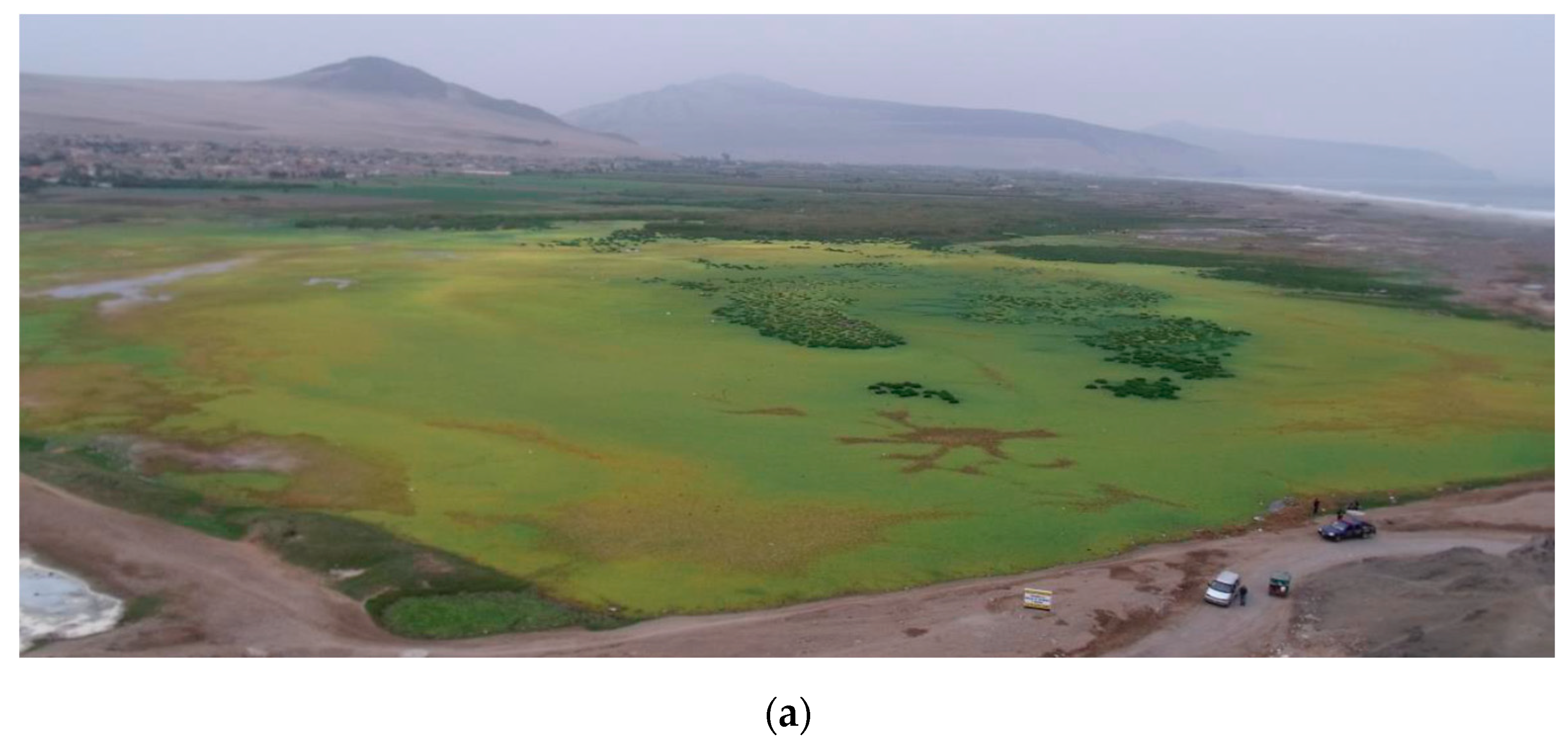
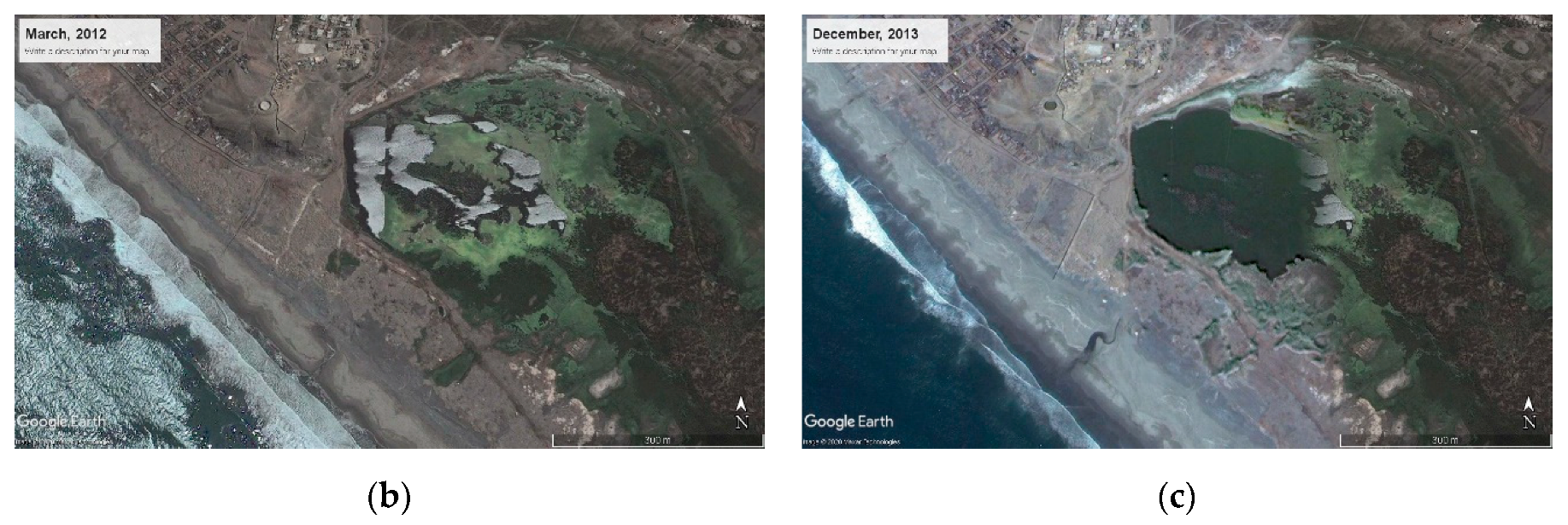
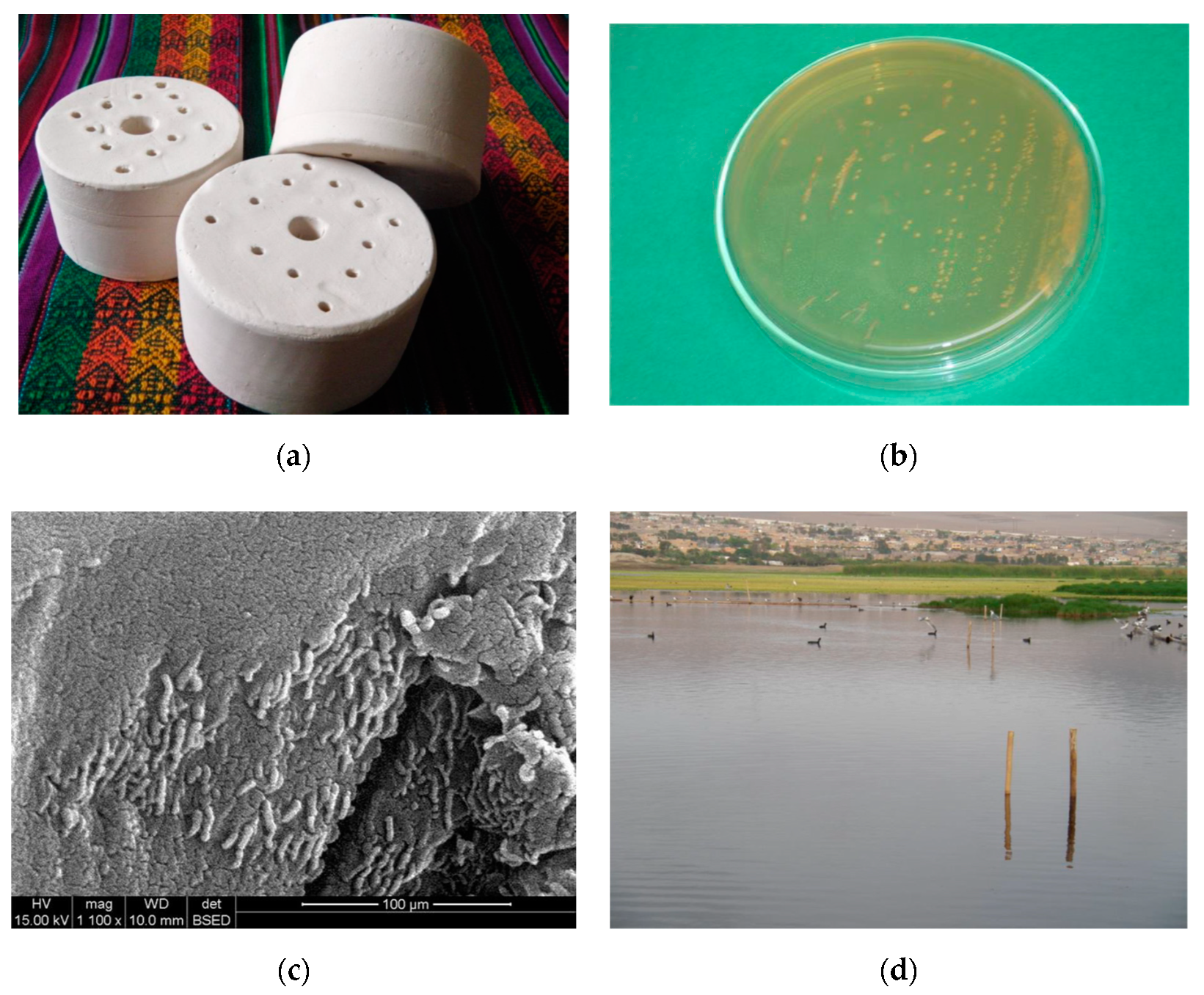
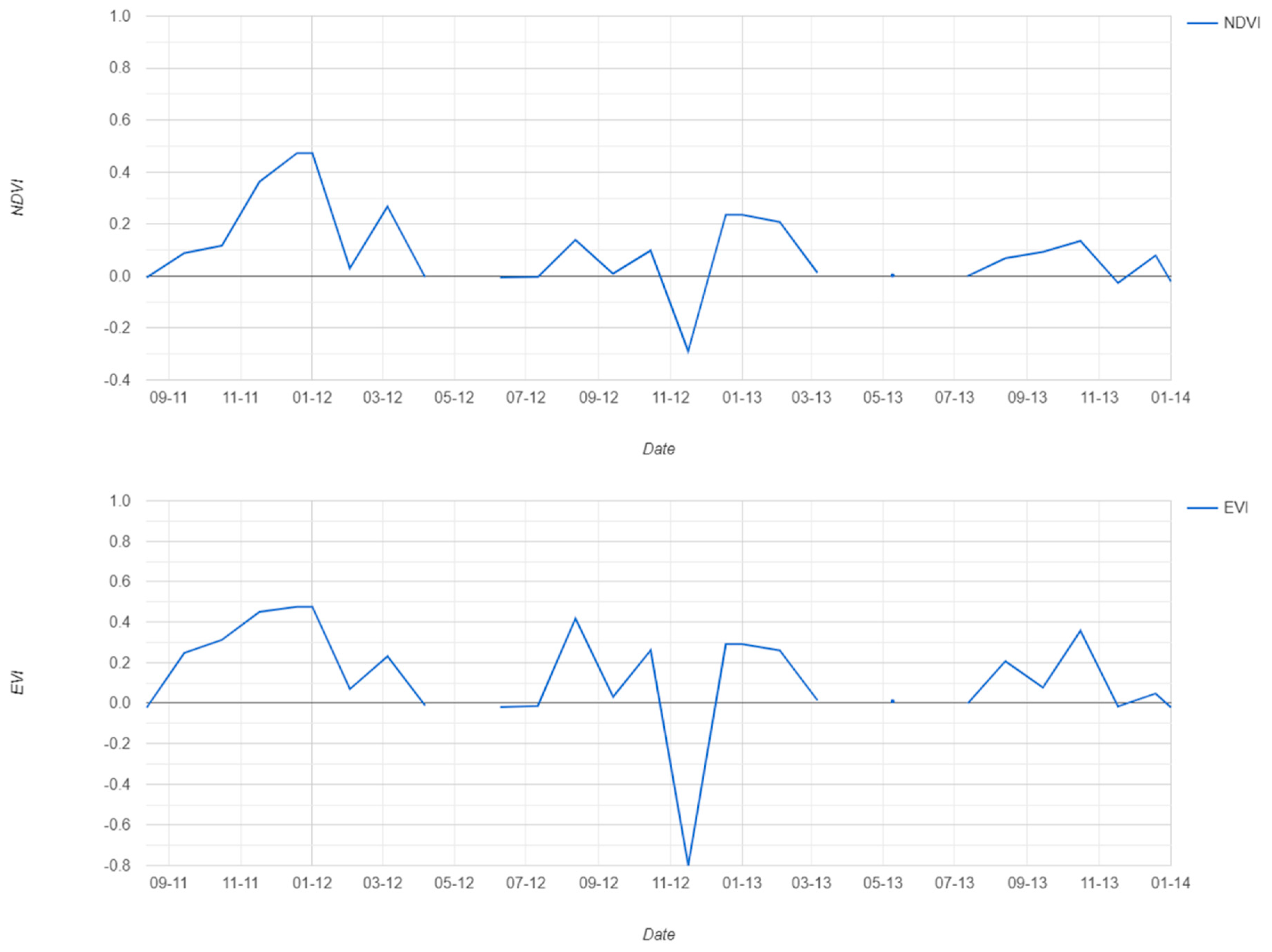
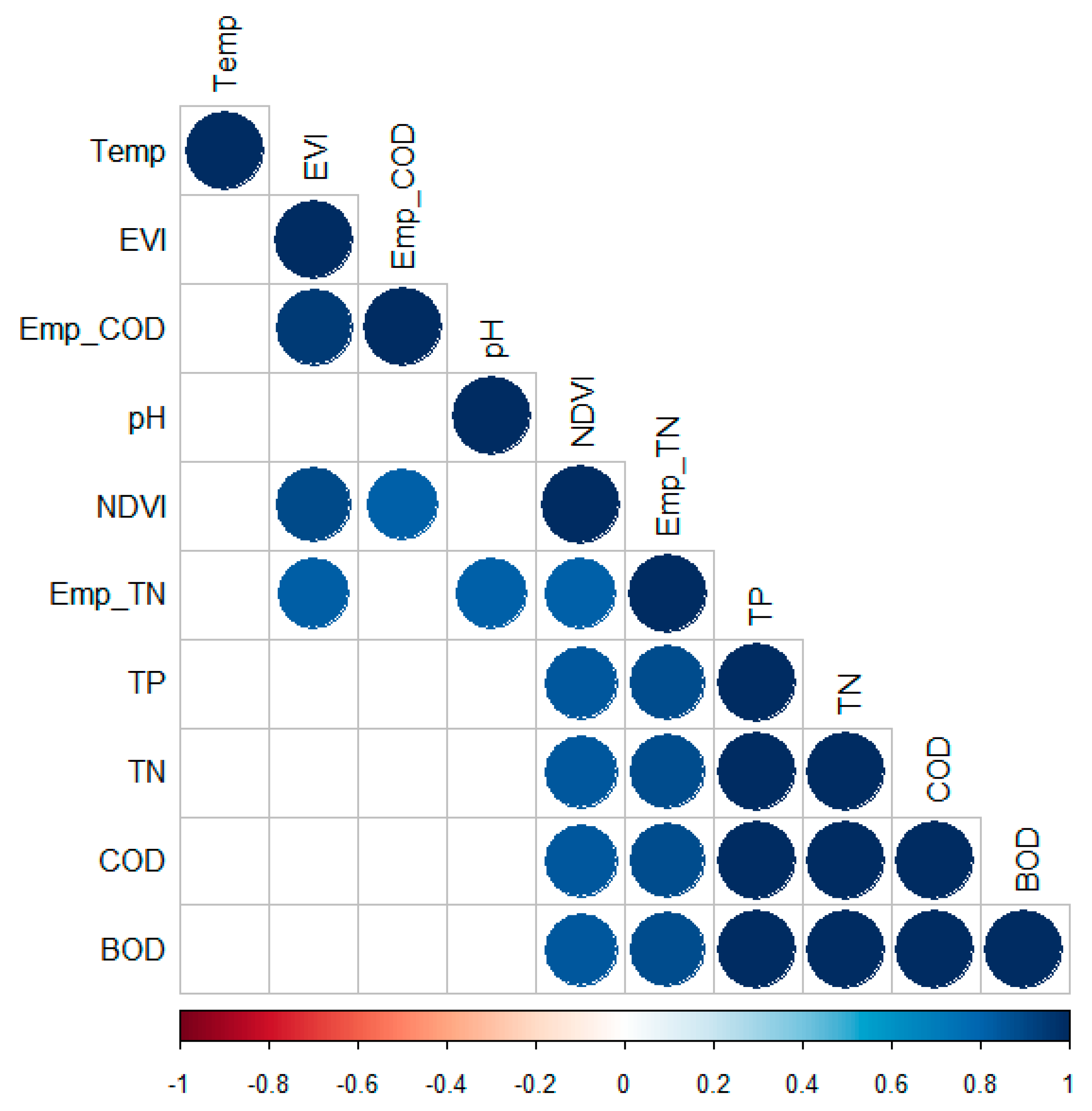
| Temperature (°C) | pH | CODm(mg/L) | BODm(mg/L) | TN (mg/L) | TP (mg/L) |
|---|---|---|---|---|---|
| 18 (0.1) *1 | 9.2 (0.3) | 1300.0 (113.1) | 494.4 (79.6) | 155.0 (17.0) | 10.2 (0.5) |
| Time | Temperature (°C)*1 | pH | COD (mg/L) | BOD (mg/L) | TN (mg/L) | TP (mg/L) |
|---|---|---|---|---|---|---|
| 23/July/2011 | 17.6 (0.8) | 8.9 (0.1) | 1295.3 (63.4) | 547.8 (4.1) | 161.6 (4.0) | 10.3 (0.2) |
| 30/July/2011 | 17.9 (0.6) | 8.7 (0.1) | 1131.0 (65.3) | 535.3 (4.2) | 154.4 (2.1) | 9.7 (0.1) |
| 23/Nov/2011 | 21.3 (0.5) | 7.6 (0.4) | 428.4 (38.5) | 168.2 (17.7) | 89.5 (4.2) | 5.1 (0.1) |
| 30/Nov/2011 | 21.0 (0.8) | 7.6 (0.1) | 304.6 (42.5) | 103.1 (18.9) | 75.6 (4.0) | 4.8 (0.1) |
| 23/Mar/2012 | 27.3 (1.0) | 7.5 (0.0) | 70.8 (1.1) | 31.7 (0.8) | 18.6 (0.7) | 2.1 (0.1) |
| 30/Mar/2012 | 24.3 (1.0) | 7.4 (0.1) | 66.1 (1.9) | 29.3 (0.5) | 16.2 (0.9) | 1.9 (0.1) |
| Time | Temperature (°C)*1 | pH | COD (mg/L) | BOD (mg/L) | TN (mg/L) | TP (mg/L) |
|---|---|---|---|---|---|---|
| Jun/2012 | 17.5 (0.7) | 7.4 (0.1) | 40.4 (8.4) | 19.0 (2.3) | 10.0 (0.5) | 1.0 (0.3) |
| Jul | 16.5 (0.7) | 7.3 (0.1) | 29.4 (8.1) | 16.5 (2.5) | 7.7 (0.6) | 0.8 (0.2) |
| Aug | 16.5 (0.7) | 7.3 (0.0) | 19.5 (1.1) | 12.3 (0.9) | 2.9 (0.2) | 0.6 (0.2) |
| Time | Temperature (°C)*1 | pH | COD (mg/L) | BOD (mg/L) | TN (mg/L) | TP (mg/L) |
|---|---|---|---|---|---|---|
| Jan/2012 | 22.8 (0.5) | 8.0 (0.3) | 72.6 (6.9) | 34.6 (7.4) | 31.7 (7.3) | 2.3 (0.9) |
| Feb | 25.0 (0.8) | 7.6 (0.2) | 68.7 (6.2) | 30.3 (4.9) | 26.2 (5.9) | 2.0 (0.7) |
| Mar | 28.3 (0.5) | 7.7 (0.2) | 64.3 (7.1) | 27.2 (5.0) | 21.9 (4.0) | 1.7 (0.5) |
| Apr | 24.5 (1.3) | 7.6 (0.1) | 58.4 (6.2) | 24.2 (3.9) | 18.6 (3.2) | 1.5 (0.4) |
| May | 20.0 (1.4) | 7.6 (0.1) | 49.7 (9.7) | 19.7 (1.6) | 15.7 (3.2) | 1.3 (0.4) |
| Jun | 17.3 (0.5) | 7.6 (0.1) | 36.8 (6.1) | 16.7 (0.7) | 12.4 (2.9) | 1.0 (0.2) |
| Jul | 17.5 (0.6) | 7.5 (0.1) | 30.0 (4.9) | 15.0 (0.8) | 9.7 (1.6) | 0.8 (0.2) |
| Aug | 16.5 (0.6) | 7.6 (0.1) | 23.4 (3.0) | 13.9 (1.3) | 7.6 (1.1) | 0.7 (0.1) |
© 2020 by the authors. Licensee MDPI, Basel, Switzerland. This article is an open access article distributed under the terms and conditions of the Creative Commons Attribution (CC BY) license (http://creativecommons.org/licenses/by/4.0/).
Share and Cite
Jindo, K.; Morikawa Sakura, M.S. Innovative Feasibility Study for the Reclamation of the Cascajo Wetlands in Peru Utilizing Sustainable Technologies. Water 2020, 12, 1097. https://doi.org/10.3390/w12041097
Jindo K, Morikawa Sakura MS. Innovative Feasibility Study for the Reclamation of the Cascajo Wetlands in Peru Utilizing Sustainable Technologies. Water. 2020; 12(4):1097. https://doi.org/10.3390/w12041097
Chicago/Turabian StyleJindo, Keiji, and Marino S. Morikawa Sakura. 2020. "Innovative Feasibility Study for the Reclamation of the Cascajo Wetlands in Peru Utilizing Sustainable Technologies" Water 12, no. 4: 1097. https://doi.org/10.3390/w12041097
APA StyleJindo, K., & Morikawa Sakura, M. S. (2020). Innovative Feasibility Study for the Reclamation of the Cascajo Wetlands in Peru Utilizing Sustainable Technologies. Water, 12(4), 1097. https://doi.org/10.3390/w12041097





